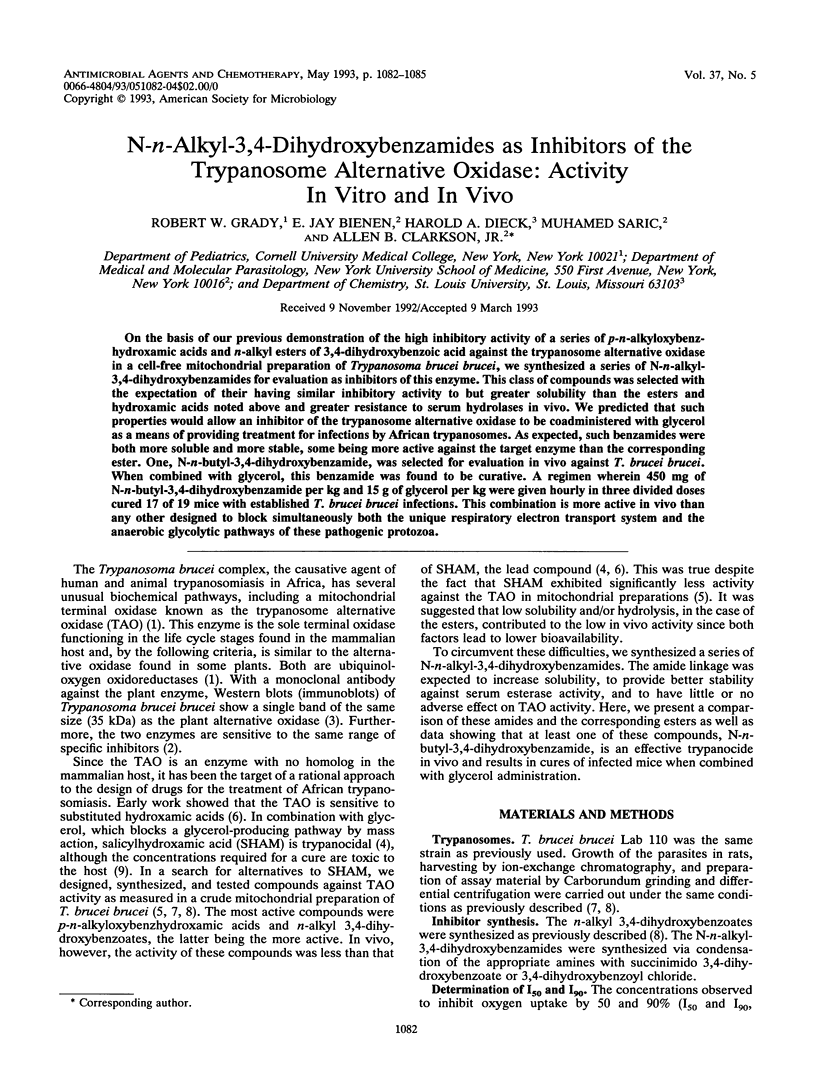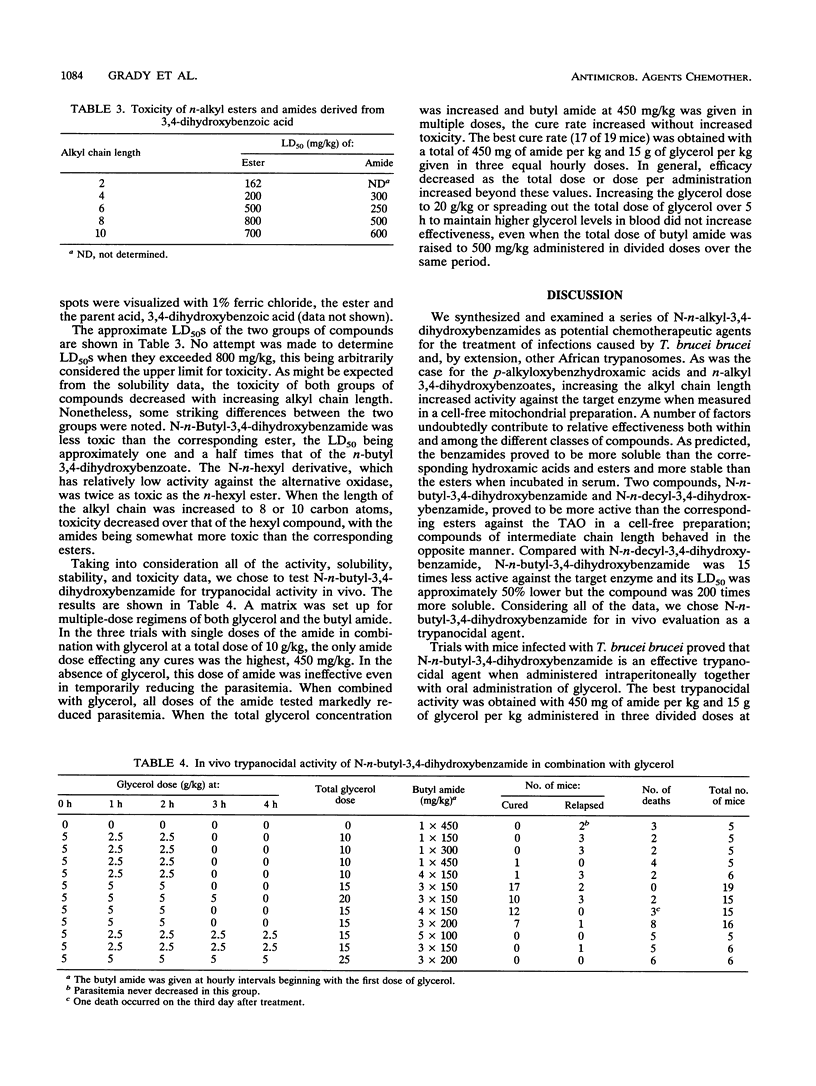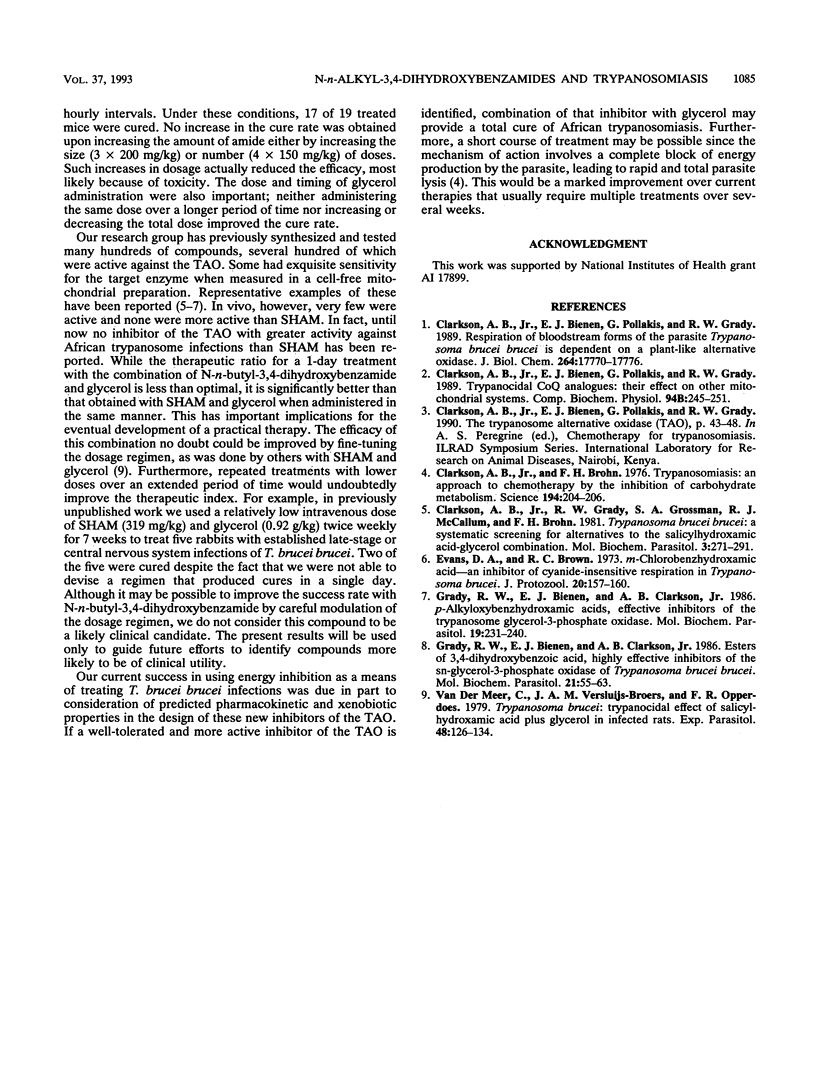Abstract
On the basis of our previous demonstration of the high inhibitory activity of a series of p-n-alkyloxybenzhydroxamic acids and n-alkyl esters of 3,4-dihydroxybenzoic acid against the trypanosome alternative oxidase in a cell-free mitochondrial preparation of Trypanosoma brucei brucei, we synthesized a series of N-n-alkyl-3,4-dihydroxybenzamides for evaluation as inhibitors of this enzyme. This class of compounds was selected with the expectation of their having similar inhibitory activity to but greater solubility than the esters and hydroxamic acids noted above and greater resistance to serum hydrolases in vivo. We predicted that such properties would allow an inhibitor of the trypanosome alternative oxidase to be coadministered with glycerol as a means of providing treatment for infections by African trypanosomes. As expected, such benzamides were both more soluble and more stable, some being more active against the target enzyme than the corresponding ester. One, N-n-butyl-3,4-dihydroxybenzamide, was selected for evaluation in vivo against T. brucei brucei. When combined with glycerol, this benzamide was found to be curative. A regimen wherein 450 mg of N-n-butyl-3,4-dihydroxybenzamide per kg and 15 g of glycerol per kg were given hourly in three divided doses cured 17 of 19 mice with established T. brucei brucei infections. This combination is more active in vivo than any other designed to block simultaneously both the unique respiratory electron transport system and the anaerobic glycolytic pathways of these pathogenic protozoa.
Full text
PDF



Selected References
These references are in PubMed. This may not be the complete list of references from this article.
- Clarkson A. B., Jr, Bienen E. J., Pollakis G., Grady R. W. Respiration of bloodstream forms of the parasite Trypanosoma brucei brucei is dependent on a plant-like alternative oxidase. J Biol Chem. 1989 Oct 25;264(30):17770–17776. [PubMed] [Google Scholar]
- Clarkson A. B., Jr, Bienen E. J., Pollakis G., Grady R. W. Trypanocidal CoQ analogues: their effect on other mitochondrial systems. Comp Biochem Physiol B. 1989;94(2):245–251. doi: 10.1016/0305-0491(89)90341-6. [DOI] [PubMed] [Google Scholar]
- Clarkson A. B., Jr, Brohn F. H. Trypanosomiasis: an approach to chemotherapy by the inhibition of carbohydrate catabolism. Science. 1976 Oct 8;194(4261):204–206. doi: 10.1126/science.986688. [DOI] [PubMed] [Google Scholar]
- Clarkson A. B., Jr, Grady R. W., Grossman S. A., McCallum R. J., Brohn F. H. Trypanosoma brucei brucei: a systematic screening for alternatives to the salicylhydroxamic acid-glycerol combination. Mol Biochem Parasitol. 1981 Sep;3(5):271–291. doi: 10.1016/0166-6851(81)90002-5. [DOI] [PubMed] [Google Scholar]
- Evans D. A., Brown R. C. m-Chlorobenzhydroxyamic acid--an inhibitor of cyanide-insensitive respiration in Trypanosoma brucei. J Protozool. 1973 Feb;20(1):157–160. doi: 10.1111/j.1550-7408.1973.tb06024.x. [DOI] [PubMed] [Google Scholar]
- Grady R. W., Bienen E. J., Clarkson A. B., Jr Esters of 3,4-dihydroxybenzoic acid, highly effective inhibitors of the sn-glycerol-3-phosphate oxidase of Trypanosoma brucei brucei. Mol Biochem Parasitol. 1986 Oct;21(1):55–63. doi: 10.1016/0166-6851(86)90079-4. [DOI] [PubMed] [Google Scholar]
- Grady R. W., Bienen E. J., Clarkson A. B., Jr p-Alkyloxybenzhydroxamic acids, effective inhibitors of the trypanosome glycerol-3-phosphate oxidase. Mol Biochem Parasitol. 1986 Jun;19(3):231–240. doi: 10.1016/0166-6851(86)90005-8. [DOI] [PubMed] [Google Scholar]
- Van Der Meer C., Versluijs-Broers J. A. Trypanosoma brucei: trypanocidal effect of salicylhydroxamic acid plus glycerol in infected rats. Exp Parasitol. 1979 Aug;48(1):126–134. doi: 10.1016/0014-4894(79)90062-6. [DOI] [PubMed] [Google Scholar]


